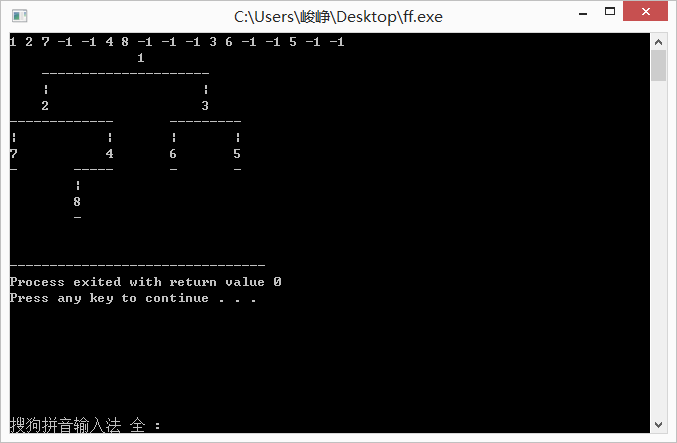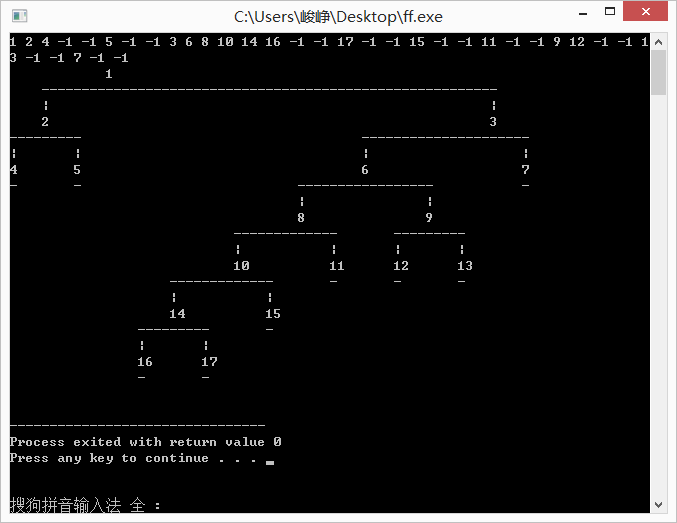#include<iostream> #include<cstring> #include<cstdio> #include<algorithm> #include<string> #include<iomanip> #include<cmath> #include<queue> #define N 100 #define MAXN 0x3f3f3f3f using namespace std; struct TreeNode{ TreeNode* child[2]; int val; int d;//距离屏幕左端的宽度 TreeNode(){ child[0] = child[1] = NULL; } }; int width; int step = 4; void buildT(TreeNode* &t){ int val; cin>>val; if(val == -1){ t = NULL; return; } t = new TreeNode(); t->val = val; buildT(t->child[0]); buildT(t->child[1]); } void widthT(TreeNode* t){ if(!t) return; widthT(t->child[0]); t->d = width; width+=step; widthT(t->child[1]); } void outT(TreeNode* t){ width=0; widthT(t); queue<TreeNode*> q; vector<TreeNode*> v; q.push(t); int n=1;//当前层的节点个数 int nn=0;//统计下一次的节点的个数 int pred;//前一个节点距离左屏幕的距离 while(!q.empty()){ TreeNode* tt = q.front(); q.pop(); v.push_back(tt); //放入孩子节点 if(tt->child[0]) q.push(tt->child[0]), ++nn; if(tt->child[1]) q.push(tt->child[1]), ++nn; if(v.size()==n){//上一层访问完毕 n = nn; nn = 0; /***************************************/ //打印节点的数值 int pred = -1;//前面的节点距离屏幕左端的距离 for(int i=0; i<v.size(); ++i) { TreeNode* x= v[i]; if(pred==-1){ cout<<setw(x->d)<<""; cout<<x->val; pred = x->d; } else { cout<<setw(x->d-pred)<<x->val; pred = x->d; } } cout<<endl; /***************************************/ /***************************************/ //打印"---------------" pred = -1; for(int i=0; i<v.size(); ++i){ TreeNode* x= v[i]; int ld=-1, rd=-1;//左右子树距离屏幕左端的距离 if(x->child[0]) ld = x->child[0]->d; if(x->child[1]) rd = x->child[1]->d; if(ld != -1) { if(pred==-1){//打印左孩子的分枝图案 cout<<setw(ld)<<""; } else { cout<<setw(ld-pred-1)<<""; } for(int j=0; j<x->d-ld; ++j) cout<<"-"; cout<<"-"; } else { if(pred==-1){ cout<<setw(x->d)<<""; } else { cout<<setw(x->d-pred-1)<<""; } cout<<"-"; } pred = x->d; if(rd != -1){//打印右孩子的分枝图案 for(int j=0; j<rd-x->d; ++j) cout<<"-"; pred = rd; } } cout<<endl; /***************************************/ /***************************************/ //打印 "|" pred = -1; for(int i=0; i<v.size(); ++i){//打印竖线,过程和上面一部分差不多,稍作修改就好 TreeNode* x= v[i]; int ld=-1, rd=-1;//左右子树距离屏幕左端的距离 if(x->child[0]) ld = x->child[0]->d; if(x->child[1]) rd = x->child[1]->d; if(ld != -1) { if(pred==-1){ cout<<setw(ld)<<""; } else { cout<<setw(ld-pred-1)<<""; } cout<<"|"; for(int j=0; j<x->d-ld; ++j) cout<<" "; } else { if(pred==-1){ cout<<setw(x->d)<<""; } else { cout<<setw(x->d-pred-1)<<""; } cout<<" "; } pred = x->d; if(rd != -1){ for(int j=0; j<rd-x->d-1; ++j) cout<<" "; cout<<"|"; pred = rd; } } cout<<endl; /***************************************/ v.clear();//清空上一层数据 } } } int main(){ TreeNode *T = NULL; buildT(T); outT(T); return 0; } /* 1 2 7 -1 -1 4 8 -1 -1 -1 3 6 -1 -1 5 -1 -1 1 2 4 -1 -1 5 -1 -1 3 6 8 10 14 16 -1 -1 17 -1 -1 15 -1 -1 11 -1 -1 9 12 -1 -1 13 -1 -1 7 -1 -1 */

